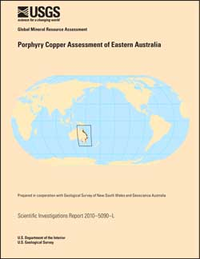Porphyry copper assessment of eastern Australia
Links
- More information: USGS Index Page
- Document: Report (36 MB pdf)
- Larger Work: This publication is Chapter L of Global mineral resource assessment
- Spatial Data: GIS package (1 MB zip)
- Download citation as: RIS | Dublin Core
Abstract
The U.S. Geological Survey (USGS) conducts national and global assessments of resources (mineral, energy, water, and biologic) to provide science in support of decision making. Mineral resource assessments provide syntheses of available information about where mineral deposits are known and suspected to occur in the Earth’s crust and which commodities may be present, together with estimates of amounts of resources that may be present in undiscovered deposits. The USGS collaborated with geologists of the Geological Survey of New South Wales and Geoscience Australia (formerly the Australian Geological Survey Organisation) on an assessment of Phanerozoic-age porphyry copper resources in Australia. Porphyry copper deposits contain about 11 percent of the identified copper resources in Australia. This study addresses resources of known porphyry copper deposits and expected resources of undiscovered porphyry copper deposits in eastern Australia.
A three-part form of assessment was used for estimation of undiscovered resources. Using this method, four tracts were delineated that are permissive for porphyry copper deposits. A probabilistic estimate of the expected number of deposits in each tract was prepared on the basis of existing information about geology, geochemistry, geophysics, exploration history, and mineral occurrences. Monte Carlo simulation was used to combine the estimated number of deposits with an appropriate model of grade and tonnage for porphyry copper deposits to provide a probabilistic estimate of metal content and total tonnage for undiscovered deposits.
The Delamerian permissive tract comprises igneous rocks of Cambrian age in the Delamerian Orogen, which borders the western margin of the Tasmanides. The Delamerian tract contains no known porphyry copper deposits, but the Adelaide sub-tract, one of three sub-tracts that compose the Delamerian tract, contains four porphyry copper prospects. The Adelaide sub-tract is estimated to contain 2.5±2.2 undiscovered deposits in an area of about 50,700 square kilometers.
The Macquarie permissive tract comprises volcanic, volcaniclastic, and minor exposed intrusive igneous rocks of the Macquarie Arc. The nine known deposits in this tract are now estimated to contain a total of about 13.5 million metric tons of copper and 1,700 metric tons of gold. This tract is estimated to contain 6.9±3.5 undiscovered deposits for a total of about 16 deposits in an area of about 41,500 square kilometers.
The Yeoval permissive tract includes subequal areas of permissive volcanic and intrusive rocks of Silurian to Devonian age exposed in and around the Cowra-Buchan Rift System, which overlaps the previously accreted Macquarie Arc. The Yeoval tract contains one porphyry copper deposit and several porphyry copper prospects. This tract is estimated to contain 1.3±0.75 undiscovered porphyry copper deposits, for a total of about 2 expected deposits in an area of about 53,200 square kilometers.
The East Tasmanide permissive tract includes a semi-continuous belt of plutonic and subordinate volcanic rocks along the eastern margins of Queensland and northeastern New South Wales. The East Tasmanide tract contains 14 known porphyry copper deposits and many porphyry copper prospects, which are all in the Central sub-tract. This sub-tract is expected to contain 4.8±3.3 undiscovered porphyry copper deposits, for a total of about 19 deposits in an area of about 291,000 square kilometers.
This assessment estimates that 15 undiscovered deposits contain an arithmetic mean of ~21 million metric tons or more of copper in four tracts, in addition to the 24 known porphyry copper deposits that contain identified resources of ~16 million metric tons of copper. In addition to copper, the mean expected amount of undiscovered byproduct gold predicted by the simulation is ~1,500 metric tons. The probability associated with these arithmetic means is on the order of 30 percent. Median expected amounts of metals predicted by the simulations may be ~50 percent lower than mean estimates.
Study Area
| Publication type | Report |
|---|---|
| Publication Subtype | USGS Numbered Series |
| Title | Porphyry copper assessment of eastern Australia |
| Series title | Scientific Investigations Report |
| Series number | 2010-5090 |
| Chapter | L |
| DOI | 10.3133/sir20105090L |
| Year Published | 2014 |
| Language | English |
| Publisher | U.S. Geological Survey |
| Publisher location | Reston, VA |
| Contributing office(s) | Crustal Geophysics and Geochemistry Science Center, Eastern Mineral and Environmental Resources Science Center, Geology, Minerals, Energy, and Geophysics Science Center, Mineral Resources Program |
| Description | Report: x, 160 p.; Spatial Data |
| Larger Work Type | Report |
| Larger Work Subtype | USGS Numbered Series |
| Larger Work Title | Global mineral resource assessment (Scientific Investigations Report 2010-5090) |
| Country | Australia |
| Datum | Geocentric Datum of Australia 1994 |
| Online Only (Y/N) | Y |
| Additional Online Files (Y/N) | Y |


